

Following the assassination of Archduke Franz Ferdinand of Austria on June 28, 1914, the Austro-Hungarians fired the first shots of The Great War (now known as World War I) on July 28, 1914 after talks failed. The United States initially remained neutral, but with the resurgence of German submarine warfare, America was forced to enter the war. Congress formally declared war on April 6, 1917. President Wilson promised he would send a division of troops. Since we had no divisions, one was quickly constituted on May 24, 1917 and designated the 1st Expeditionary Division as it really was our first division. To help boost morale, General Pershing had the troops, including the second battalion of the 16th Infantry regiment (the original owner of our Featured Stein was a member of that unit), parade through Paris on July 4, 1917. They stopped at the tomb of Marqis de Lafayette where Colonel Charles E. Stanton uttered those famous words, "Lafayette, nous voilà" (Lafayette, we are here). The 1st Expeditionary Division was redesignated the 1st Division on July 6, 1917. The red numeral 1 on an olive patch was officially approved in October 1918 and the division would become known as “The Big Red One.” It also was nicknamed “The Fighting First.” The unit’s fame was such that a movie entitled “The Big Red One” starring Lee Marvin and Mark Hamel was made in 1980. The Society of the 1st Infantry Division has two legends behind how the patch came to be if you are interested. I prefer the first legend as I have a hard time believing a lieutenant would be so bold in talking to a general (or colonel1) as the second legend would have you believe.2 Hostilities for The Great War ceased on the eleventh hour, of the eleventh month of November 1918. This was supposed to be the war to end all wars, but it also probably should have not been a war considering the events that led up to it. Approximately 16 million died in The Great War and another 20 million were wounded.3 These figures do not include the 50 to 100 million that died during the 1918 Flu Pandemic that the troops and supporting personnel were partially responsible for helping its spread as they travelled to various countries. France, Germany, Great Britain and the United States censored information on the pandemic so as not to hurt morale. Spain was free to report their deaths and this is why it became known as the Spanish Flu.4
This stein features three doughboys (the term doughboy5 originated in the Mexican-American War, 1846-1847, and was only applied to the infantry) standing in front of a piece of artillery. One soldier has a garrison cap while the other two soldiers are wearing helmets and trench coats and are carrying rifles. One doughboy’s rifle is slung over a shoulder and the other has the rifle resting on his shoulder as if he were marching.
 The figures are in relief. It is obvious from the one doughboy wearing a garrison cap that they are not
near the front lines. Why did the artist choose to show a triad of soldiers? Besides being a prime number,
three is considered to be a magic number that keeps reoccurring in society. If you were in the Army, you
know that lighting three cigarettes on one match could get you killed – one to see, two to aim and three
to fire. Here, however, I think the artist is showing a sergeant (although none of the soldiers displays
their rank) changing the guard. The lid is a tin type found on
jugendstil or art deco steins. It is very similar to the type of helmet worn by our doughboys.
The bottom of the stein features a panorama view near the front lines of a battlefield. The top of each
side of the stein features scenes of two different bombed out buildings. This is the basic stein that
could then be decorated for various U.S. Army units. I have seen this stein for both the First Division
and the 32nd Division. My stein features the “Big Red One” patch surrounded by a laurel wreath on the
left side of the stein and a list of the major battles in a red circle that the 1st Division participated
in during The Great War on the right side of the stein. The top of the stein shows the name of the
soldier and his unit. Sometimes it will say “Army of Occupation,” “1917-1919” or “Les Terribles
Army
of Occupation across the Rhine.” The latter one, showing the nom de guerre given to them by the
French Army, is found on steins for the 127th Infantry, 32nd Division.
The figures are in relief. It is obvious from the one doughboy wearing a garrison cap that they are not
near the front lines. Why did the artist choose to show a triad of soldiers? Besides being a prime number,
three is considered to be a magic number that keeps reoccurring in society. If you were in the Army, you
know that lighting three cigarettes on one match could get you killed – one to see, two to aim and three
to fire. Here, however, I think the artist is showing a sergeant (although none of the soldiers displays
their rank) changing the guard. The lid is a tin type found on
jugendstil or art deco steins. It is very similar to the type of helmet worn by our doughboys.
The bottom of the stein features a panorama view near the front lines of a battlefield. The top of each
side of the stein features scenes of two different bombed out buildings. This is the basic stein that
could then be decorated for various U.S. Army units. I have seen this stein for both the First Division
and the 32nd Division. My stein features the “Big Red One” patch surrounded by a laurel wreath on the
left side of the stein and a list of the major battles in a red circle that the 1st Division participated
in during The Great War on the right side of the stein. The top of the stein shows the name of the
soldier and his unit. Sometimes it will say “Army of Occupation,” “1917-1919” or “Les Terribles
Army
of Occupation across the Rhine.” The latter one, showing the nom de guerre given to them by the
French Army, is found on steins for the 127th Infantry, 32nd Division.
The stein does not show any manufacturer’s mark, mold number, country of origin or capacity mark. I did measure the inside of the stein to calculate the volume and it will hold ½ liter of beer. The absence of a country of origin indicates that it was made and delivered in Germany and there was no need to show capacity as it was being sold to Americans, not Germans. The stein was no doubt made in 1919. While the war ended on November 11, 1918, it would be ten months before the final troops made it home. The last unit to leave Europe was an honor bestowed on the 1st Division and General John J. Pershing would accompany his favorite unit home to lead them on their victory parades. The troops were issued new uniforms for the occasion. The division was also reissued all of their authorized equipment for the parades in New York City and Washington, D.C. The New York City parade was six miles long and took four hours to pass one point.1 There were a couple of reasons for the ten-month delay in redeploying the troops home. While the war ended on November 11, 1918, Germany did not sign the terms of peace until June 28, 1919. The American Expeditionary Forces (A.E.F.) were needed in case hostilities started again. Secondly, the logistics of bringing back approximately two million men across an ocean would take time. This gave the troops a lot of time to acquire souvenirs to bring back with them. The Big Red One was at Verdun at the end of the war and on November 17, 1918 was ordered to advance “…through Luxembourg and then along the west bank of the Moselle River to their bridgehead assignment, 200 kilometers away, on the east bank of the Rhine at Coblenz.” They reached Trier, Germany on December 10, 1918.1 The division was headquartered at Montabaur, Germany near Coblenz, Germany. In the 1920s the hard “c” was being replaced with a “k” to make it sound more German, thus Coblenz became Koblenz in 1926.6 Similarly, the grandson of the founder of Albert Jacob Thewalt was named after the founder but his middle name was spelled with a “k” as he was born in 1926. The troops no doubt were aware of the practice of German reservists purchasing beer steins to commemorate their service time. Furthermore, they were close to Höhr and Grenshausen (these two cities would eventually merge and form Höhr-Grenshausen in 1936) where beer steins were a major industry. Did the troops come up with the idea of a souvenir beer stein or did some German decorator, who no longer had a clientele to sell to, come up with the idea of selling a souvenir stein to the occupying Army? We may never know, but my bet is on an enterprising decorator looking for a way to survive the hard times in post-war Germany. While the stein is not marked, we have a pretty good idea that it was made by Dümler & Brieden (DB) based on the handle. The Beer Stein Library has a Westerwald Beer Stein Handle Gallery showing various handles by beer stein manufacturers. Photo 38 shows DB 19 which is the handle on this stein. Membership is required to view the gallery at The Beer Stein Library. It is somewhat ironic that this firm would make a stein for a former foe as one of the co-founder’s sons, Paul Dümler, who became the managing director upon his father’s death in 1907, was killed in action in France at the start of The Great War in 1914.
I have seen reference to seven of these American WWI regimentals. Don Franz did an article entitled “American World War I Regimental Steins” in the December 1984 Prosit, page 1260. This featured three of these steins, although only two were photographed. One had a conical lid, which was obviously a replacement as the tin jugendstil lid is a natural lid for this stein. A fourth stein was reported in Jim Riley’s article entitled “A WWI US Military Stein and a Circus?” in the June 2009 Prosit, page 4. A fifth stein appeared on SteinTalk on August 6, 2012 when Tom R wanted to know more about one of his relative’s stein. The sixth was the one I acquired and is the stein featured in this article. The seventh was one I just happened to find in the unlikeliest of places as discussed in the next paragraph. The names and units shown on the known American regimental steins are as follows:
| Name | Unit |
| Earl W. Hartwig | 127th Inf. Supply Co., 32nd Div. |
| Hugh L. Finnegan | 127th Inf., 32nd Div. |
| Wag. J. F. Connolly | Hdq. Co., 127th Inf., 32ndDiv. |
| Joseph H. K. (unknown) | 1st Amm. Train Co. C, 1st Div. |
| Pvt. 1cl Ralph C. Smith | Co. H, 16th Inf, 1st Div |
| Sgt. John Spinnett | Co. E, 16th Inf., 1st Div. |
| R. S. Sgt. Abe Cohen | 127 Inf., 32nd Div. |
Since the United States mobilized more than four million military personnel for the war with slightly more than half the mobilized troops being deployed to Europe7 in 51 divisions, there are bound to be many more of these steins and different divisions out there. Perhaps some are even in a hallowed space on the mantle of one of their descendants.
I have a strong feeling that the image displayed on the face of this stein is based on a prior artwork. I have searched hundreds of images of WWI posters, postcards, war memorials
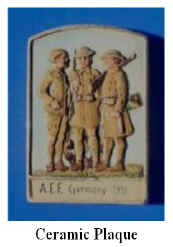 and war monuments without
success. I was encouraged by one find though. I found a ceramic plaque that sold on eBay on May 5, 2011
that featured the same image, see photo.
The inscription at the bottom of the image is “A.E.F. Germany 1919.” The plaque looks like it
might be something that was placed on a monument or other type of memorial. Please let me know if you
recognize it.
and war monuments without
success. I was encouraged by one find though. I found a ceramic plaque that sold on eBay on May 5, 2011
that featured the same image, see photo.
The inscription at the bottom of the image is “A.E.F. Germany 1919.” The plaque looks like it
might be something that was placed on a monument or other type of memorial. Please let me know if you
recognize it.
The original owner of our Featured Stein was Sgt. John Spinnett.8 Sgt. Spinnett was born on April 19, 1894 in New Bedford, MA and died December 19, 1936 in a truck accident in Portsmouth, RI. He was buried in New Pawtuxet Cemetery in Warwick, RI and the government provided a free headstone to mark his grave. He was married on June 15, 1921 in Providence, RI to Lillian Lee, but he did not have any children. Sgt. John Spinnett enlisted on November 5, 1913,
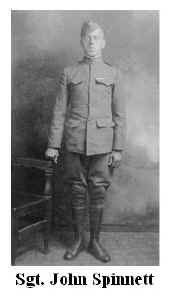 was promoted from private to
sergeant in October 1918 and was discharged on February 29, 1920 with a furlough to the reserves.
He was honorably discharged on June 4, 1920.9 Per the Military Times, his Silver Star Citation
reads as follows: “By direction of the President, under the provisions of the act of Congress
approved July 9, 1918 (Bul. No. 43, W.D., 1918),
Sergeant John Spinnett (ASN: 42634), United
States Army, is cited by the Commanding General, American Expeditionary Forces, for gallantry
in action and a silver star may be placed upon the ribbon of the Victory Medals awarded him.
Sergeant Spinnett distinguished himself by gallantry in action while serving with Company E, 16th
Infantry Regiment, 1st Division, American Expeditionary Forces, in action south of Sedan,
France, on the night of 5 - 6 November 1918, while conducting a machine-gun platoon in the
was promoted from private to
sergeant in October 1918 and was discharged on February 29, 1920 with a furlough to the reserves.
He was honorably discharged on June 4, 1920.9 Per the Military Times, his Silver Star Citation
reads as follows: “By direction of the President, under the provisions of the act of Congress
approved July 9, 1918 (Bul. No. 43, W.D., 1918),
Sergeant John Spinnett (ASN: 42634), United
States Army, is cited by the Commanding General, American Expeditionary Forces, for gallantry
in action and a silver star may be placed upon the ribbon of the Victory Medals awarded him.
Sergeant Spinnett distinguished himself by gallantry in action while serving with Company E, 16th
Infantry Regiment, 1st Division, American Expeditionary Forces, in action south of Sedan,
France, on the night of 5 - 6 November 1918, while conducting a machine-gun platoon in the
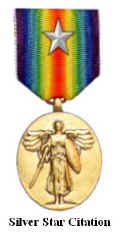 attack against an enemy gun position.”10 The Silver Star medal and ribbon replaced the
Silver Star Citation on July 19, 1932 (passed into law by Congress in 1942) and previous
recipients are authorized the new medal. While detail records are not maintained by the Department of Defense,
independent groups
estimated that 100,000 to 150,000 Silver Stars have been awarded.11 That may seem
like a lot, but when you consider the number of personnel in the Armed Forces during the period of
its existence that amounts to less than 0.5 per cent issuance rate. That percentage would be higher
if you only considered the troops actually in the combat zone. Compare that to one of Germany’s
attack against an enemy gun position.”10 The Silver Star medal and ribbon replaced the
Silver Star Citation on July 19, 1932 (passed into law by Congress in 1942) and previous
recipients are authorized the new medal. While detail records are not maintained by the Department of Defense,
independent groups
estimated that 100,000 to 150,000 Silver Stars have been awarded.11 That may seem
like a lot, but when you consider the number of personnel in the Armed Forces during the period of
its existence that amounts to less than 0.5 per cent issuance rate. That percentage would be higher
if you only considered the troops actually in the combat zone. Compare that to one of Germany’s
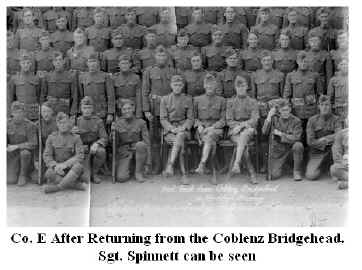 more famous medals, the Iron Cross. Over five million Iron Crosses were issued in The Great War.12
Even Hitler was awarded the Iron Cross. The Silver Star is the third highest award in the U.S. military.
It is truly an elite award for gallantry in action. Our hero participated heroically in a great war
and marched in three famous parades.
more famous medals, the Iron Cross. Over five million Iron Crosses were issued in The Great War.12
Even Hitler was awarded the Iron Cross. The Silver Star is the third highest award in the U.S. military.
It is truly an elite award for gallantry in action. Our hero participated heroically in a great war
and marched in three famous parades.
There are other beer steins and mugs that were sold to the doughboys in 1919. I previously mentioned that the American Expeditionary Forces were retained in Europe while the treaty terms were being negotiated. The troops needed to be kept busy to keep them out of trouble while they awaited deployment back home. Recreational and entertainment activities were two sources that were used to occupy the troops spare time. One of the more enterprising activities was the First Division Circus at Montabaur, Germany. The huge success led to another showing in Cologne (now Köln), Germany and additional showings in Louisville, KY; Indianapolis, IN and Chicago, IL when the troops returned to Camp Zachary Taylor in Louisville, KY after The Great War. This circus was discussed by Jim Riley in his article referenced in paragraph five of this article. For SCI members, a digital copy of that article can be found in the Members Only section of this site. Those short 0,5 L mugs or steins (some came with lids) look similar to ones made by Marzi & Remy. The First Division Circus was a huge success and helped the division raise funds for recreational purposes as well as providing funds to establish memorials to the division’s battles in Europe and to construct a World War I memorial in Washington, D.C.13
Click on this link, http://www.riley.army.mil/bigredone/divisionsong.aspx, to open a new window. This will allow you to play the 1st Division song while you return to this window to continue reading the conclusion of this article.
Beginning in 1919, November 11th was designated Armistice Day. In 1954, it was decided to recognize all veterans by changing the name to Veterans Day. In 1968 the Uniform Monday Holiday Act moved Washington’s Birthday, Memorial Day, Columbus Day and Veterans Day so Federal workers
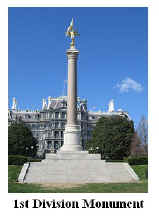 could have a three-day holiday.
This did not please some groups and in 1971 Veterans Day was restored to November 11th beginning in 1978.
Please join me in a minute of silence to pay tribute to Sgt. John Spinnett, the 1st Division, the
American Expeditionary Forces,
those service men and women currently serving our country (especially those in harm’s way) and all
the veterans of this great nation. The 1st Division Monument shown in the accompanying photograph
was established in 1924 and is located in President’s Park in Washington, D.C.
could have a three-day holiday.
This did not please some groups and in 1971 Veterans Day was restored to November 11th beginning in 1978.
Please join me in a minute of silence to pay tribute to Sgt. John Spinnett, the 1st Division, the
American Expeditionary Forces,
those service men and women currently serving our country (especially those in harm’s way) and all
the veterans of this great nation. The 1st Division Monument shown in the accompanying photograph
was established in 1924 and is located in President’s Park in Washington, D.C.
The television series Naked City (1958-62) concluded each episode with the following narration: “There are eight million stories in the Naked City. This has been one of them.” Well, there are millions of steins out there and this has been the story behind one of them. What story does your stein have to tell? Send your stein stories to the WebMaster at SCI.
References:
- “Watch On the Rhine:The First Division in the Occupation of Germany, 1918-1919,” by Paul Herbert, Executive Director of the Cantigny First Division Foundation in Wheaton , Illinois, part of Chicago’s McCormick Tribune Foundation.
- The two legends on the Big Red One patch can be found at http://www.1stid.org/patch.php.
- World War I casualties: "http://en.wikipedia.org/wiki/World_War_I_casualties"
- 1918 Flu Pandemic: http://en.wikipedia.org/wiki/1918_flu_pandemic.
- Origin of the name doughboys at the Doughboy Center: http://www.worldwar1.com/dbc/origindb.htm.
- Change of Coblenz to Koblenz: http://www.eupedia.com/germany/koblenz.shtml.
- The Doughboy Center, Manpower, Organization & Casualties: http://www.worldwar1.com/dbc/facts.htm
- Special thanks to Kerry Fisher for providing access to her family tree and photos: John Spinnett family tree: http://www.wikitree.com/genealogy/Spinnett-Family-Tree-11.
- Per the Monthly Roster and Muster Roll of Company E, 2nd Battalion, 16th Infantry provided by Andrew Woods, Research Historian, Colonel Robert R. McCormick Research Center, First Division Museum at Cantigny.
- Silver Star Citation for Sgt. John Spinnett: http://www.worldwar1.com/dbc/facts.htm
- Silver Star: http://en.wikipedia.org/wiki/Silver_Star.
- German Iron Cross: http://en.wikipedia.org/wiki/Iron_Cross.
- First Division Circus by Lieutenant F. E. Coyne, Jr., Editor of “Bridgehead Sentinel,” which is the official publication of The Society of the 1st Division.
- American Battle Monuments Commission has some interesting videos of action during The Great War at http://www.abmc.gov/multimedia/ww1/index.html.
- The 1st Division is located at Fort Riley in Kansas. Their web site is at http://www.riley.army.mil/.
- The First Division Museum at Cantigny is located in Wheaton, IL. Their web site is at http://www.firstdivisionmuseum.org/.
- The Society of the 1st Division has a web site at http://www.1stid.org/.